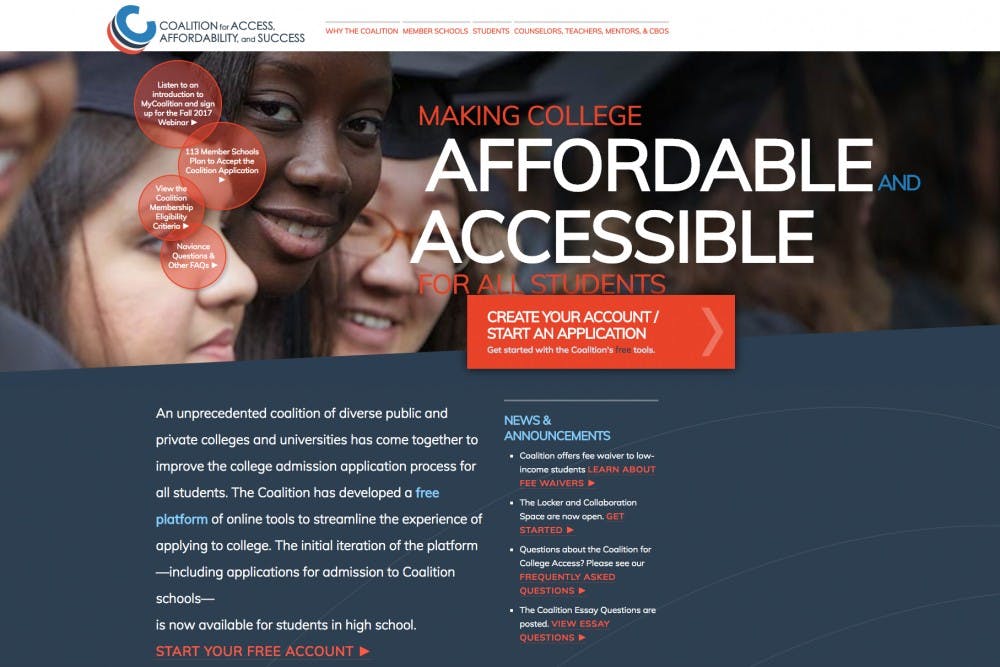
Screenshot from Coalition for Access, Affordability, and Success
Almost all current Penn students were admitted through The Common Application, an organization used by 731 colleges that offers a method for students to apply to multiple universities using one application. In the past, students could gain admission to Penn only through the Common App or, for a select few, through the QuestBridge National College Match program. For the first time, however, the Class of 2022 will also have the option of applying through a new service: the Coalition Application.
The Coalition for Access, Affordability, and Success officially launched last year for the 2016-17 application cycle and offered 46 member school applications, including Yale University.
According to Coalition Executive Director Annie Reznik, roughly 100 confirmed member schools will accept applicants using the Coalition for the 2017-18 cycle, including the entire Ivy League and state flagship schools, such as Pennsylvania State University and University of Pittsburgh.
“We’re really fortunate to have Penn as [a member] in particular,” Reznik said. “There is such a great opportunity for students in the state of Pennsylvania to have Pennsylvania’s Ivy League institution, as well as Pennsylvania’s leading public universities."
While Penn is a member of the Common App, Penn State and Pitt are not. Reznik said the Coalition has made it possible for students to apply to all three using one application.
"It’s a really nice setup for students who want to stay in their home state, and the state in general to retain talent," she added.
Part of the Coalition's mission is focused on making the college application process easier and more affordable, particularly for students from disadvantaged backgrounds.
For College sophomore and Penn First Co-Mentorship Chair Daniel Gonzalez, the Coalition’s transparent process of obtaining application fee waivers is an example of such an improvement. He said that when he applied to college, getting a fee waiver was “a fickle process, where you get it or you don’t, and you don’t even know why.”
Gonzalez said that, were he applying to Penn today, he would opt to use the Coalition Application.
As a newer program, the Coalition also has a couple key technological advantages over the Common App.
The “Coalition Locker” is a cloud-storage space that enables students to upload digital media, such as essays and resumes, at any point throughout high school, with the intention of eventually including these items in their college applications.
The feature is intended to be particularly useful for low-income students without access to a computer.
Nancy Griesemer, the founder of college counseling service College Explorations LLC, highlighted the ability to upload a personal essay to the Coalition Application, rather than manually entering text into the Common App, as a major benefit.
“They can turn their essays into PDFs which gives them a great deal of flexibility in terms of content and also gives them the opportunity to really control how their essay looks,” Griesemer said. “That’s a real difference right there.”
But some critics say the service also has flaws.
Brian Taylor, the managing director of the college counseling service Ivy Coach, said the Coalition Application has a smaller number of member colleges than the Common App.
“Why should you have to go to the great length of filling out this whole other application when so many schools don’t subscribe to the Coalition Application?” Taylor said. “Why not just do it all on one application? It’s easier for everybody.”
Penn Dean of Admissions Eric Furda, the former Board of Directors chair of the Common App, said he would wait until this application cycle concludes before drawing any conclusions on the differences between the two platforms.
“Students with both The Common Application and The Coalition are held to the same high standards and Penn Admissions does not favor one application over the other,” Furda wrote in an emailed statement.
Reznik commended Furda's efforts to attract applicants from low-income backgrounds and create more accessible pathways into the University, noting that “in the field of admissions, he is a celebrity."
One criterion for schools seeking membership for the Coalition App is a minimum graduation requirement of 60 percent. This requirement was originally 70 percent, but was lowered following the formation of a task force led by Bill Fitzsimmons of Harvard University and Zina Evans of the University of Florida.
“I think a lot of times in the national media or in different guidebooks this idea of 'fit' can overemphasize things like ‘a lot of green space,’” Reznik said. “[These are] things that are important and might make students feel more comfortable, but they’re not as important a characteristic as something like graduation rate.”
Taylor, however, did not see a purpose for this arbitrary bar for membership. He said it was likely to be an advertising tactic and likened the minimum requirement to “maybe the same reason why an empty bar keeps a line outside.”
Griesemer compared the Common App and the Coalition Application to “Coke and Pepsi.” She believes that competition between the two platforms will ultimately benefit students as both platforms continue to adapt positive features from each other.
“I think both platforms are working hard in [improving accessibility],” Griesemer said, “and I think both platforms are doing a great job.”
The Daily Pennsylvanian is an independent, student-run newspaper. Please consider making a donation to support the coverage that shapes the University. Your generosity ensures a future of strong journalism at Penn.
Donate




